How to diagnose dampness - Free Technical Help - 01626 872886 - discuss your building problem with a Qualified Dampness Expert (C.R.D.S.)
Quick DIY Master Class in Dampness and Condensation - become your own Expert in 1 hour! Buy our "Dampness in Buildings" reprinted book by the great expert Graham Coleman. A great read, short and to the point.
Click here to buy the reprint.
Check for yourself - look for these clues in the photographs below
1. Can you see the original damp proof course?
Yes = it looks like a dark line and if I scrape it looks like slate or bitumen/felt. (It is most likely to be just under the air brick, if you have a timber floor, as part of the original protection of the floor joists)
No = there may not be one, or, more likely it has been covered over with soil, steps, pathways, roadways or other building alterations. This is called 'bridging' the damp proof course and will give you all the symptoms of rising damp.
2. Is the damp proof course line that you can see about 6" (150mm) or more above the outside ground?
Yes = good, that is correct. This drop from the DPC to the ground is to protect against splash-up by falling rain. Check that the gutters and downpipes are in good condition and go outside in pouring rain to check that they can cope in a downpour.
No = bad. You will either need to lower the ground level or insert a new DPC at the correct height and 'tank' the walls below that new level.
3. Can you see fluffy white 'salts' on the wall?
Yes = you have rainwater splash up or gutters overflowing. Or, under a window frame, you may not have a clean 'drip' slot. Check the exterior walls for defects, check gutters and downpipes, check the pointing in the joints, treat with Ultra Proof waterproofer.
No = your dampness may be due to 'hygroscopic salts' deposited in the wall from chimney deposits (after burning coal or wood), or from a previous use of the building (e.g. coal shed, animal food store, butchers shop). Treat with Salt Neutraliser and replaster to our 'tanking' specification using BondAcryl. In severe cases it is best to use the Mesh Membrane wall lining system, rather than 'tank' or replaster - chimney salts can burn back through even the best render backing coats sometimes.
4. Do you have a cavity wall or a solid wall?
Yes = because you see only bricks laid along their length - no brick ends visible at any level. This type of wall should resist water penetration, because of the air gap. If it is showing damp symptoms on the inside the cavity may be blocked or the wall ties may be dirty.
No = this wall is of solid construction. You can see rows of brick 'stretchers' and then mixed rows of 'headers' and 'stretchers'. Penetrating damp or splash up rainwater can go straight through.
5. Have you got a timber floor?
Yes = look for the air bricks. Even if they are present the floor itself may have rotted and been replaced in concrete, 'bridging' the DPC and often causing rot in the skirting boards.
No = no air bricks, all concreted. Check you do not have partial solid floors, with sections of timber flooring cut off from an air supply - they will rot.
6. Are you sure that you still have a timber floor?
Yes = find the air bricks. Even if they are present the floor itself may have rotted due to blockage or shortage of air flow. Fit new bricks to the current standard.
No = the old air bricks are still there on the outside but it is filled with concrete inside. Take them out and make good with bricks and mortar, unless they are acting as cavity wall vents or provide ventilation, via a pipe, to a remote timbered area.
Can you see a water source
A. Green stuff on the wall - look up - are the gutters and downpipes OK in a really heavy downpour?
B. White stuff on the wall - it indicates dampness - check window cill 'drips', roof tiles and slates, flashings and abutting structures (even stored goods against the wall).
C. Neighbours garden, road, path or garden higher than yours - water flows downhill!
D. Water leak from underground - is an area of garden or path strangely green at the height of a Summer drought?
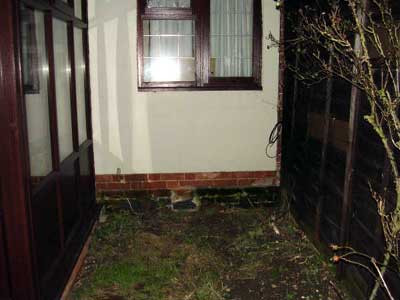
Surface salting also visible
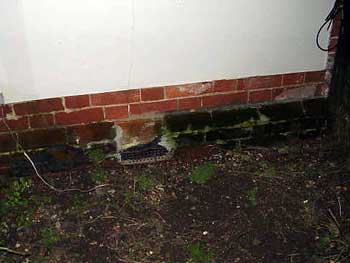
Green 'verdigris' caused by rain water splash up

Salting in brickwork above the DPC
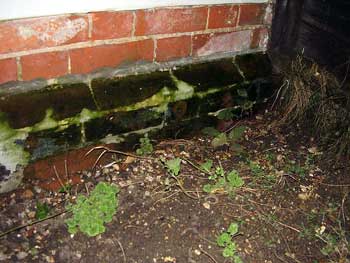
Internal view - wet skirting boards
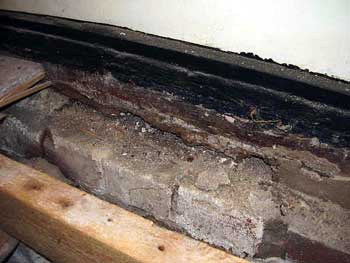
How to install a damp proof course - first, check for high ground levels, leaking gutters and downpipes, water leaks.
1. Drill 12mm diameter holes at 115mm intervals in the mortar course (or via the brickwork, angled down to meet the mortar course) selected to be at least 150mm above outside or abutting ground level
2. Fit the extension nozzle to the cartridge tube and load into the skeleton gun
3. Inject cream from the bottom of the hole outwards until the hole is full.
4. Replaster to our specification. Treat any skirting boards or joinery with Boron Ultra Gel.
Holes can be capped with mortar or fitted with a plastic plug
Replastering to a minimum of 1.2 metres internally, to our specification, using sand and cement and Rendapruf integral waterproofer, is required to finish the job and to prevent 'salts' damage to plaster finishes and decorations.
Our Products required: Quick Cream DPC, Skeleton Gun - either a 380cc or professional 1000cc
Optional Products: Rendapruf Replastering Additive (5 litre), Wall Plugs, Boron Ultra Gel (2.5 litre), UltraProof exterior wall treatment (5 litre or 25 litre), Anti-Mould Paint (2.5 litre), Condensation Testing kit, Salt Neutraliser (5 litre), BondAcryl Tanking liquid (5 litre).
Tools Required: 12mm masonry bit, electric hammer drill, eye protection.
Typical usage rates:
4.5 inch thick (115mm) single leaf wall - 1000cc (1 litre) per 9 metres, inject from either side
9 inch thick wall (230mm) double leaf solid or cavity - 1000cc(1 litre) per 4.5 metres, inject from one side or from both sides.
18 inch thick wall (460mm) solid or random fill - 1000cc (1 litre) per 2 metres, inject from both sides
Installing a Cream DPC

How Rising Dampness is Blocked
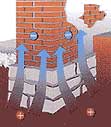
Before Treatment
After Treatment
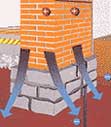
Membrane | Privacy Policy | Returns Policy | Contact
Property Repair Systems
T: 01626 872886
Use any of our Shopping Pages to place goods in your Shopping Cart - they all use the same Shopping Cart system.

Click to view your Shopping Cart
or continue shopping by clicking on our Membrane Shop link below.
Other Property Repair Systems Sites:
www.boron.org.uk - how to use Boron based insecticides/fungicides to treat timber rots and insect attack
www.dampness-info.co.uk - how to treat penetrating dampness in walls and plaster
www.deck-treatment.co.uk - how to treat patio decks and yacht decks
www.dryrot.biz - how to kill Dry Rot in buildings
www.epoxy-info.co.uk - epoxy resins for repairing wood, concrete, brick and stone
www.fire-door-paint.co.uk - upgrade doors to 30 minutes fire resistance
www.joist-repair.co.uk - how to quickly repair joists and beams of any size
www.propertyrepairsystems.co.uk - our Home Site
www.steel-fire-paint.co.uk - treat steel with Intumescent Paint to provide fire protection
www.timber.org.uk - systems of repair, with step by step methods
www.timber-repair.co.uk - how to repair timber beams
www.woodworm-info.co.uk - how to kill and prevent woodworm and death watch beetle
www.woodworm-expert-advice-forum.org.uk - all your questions and our answers about woodworm treatment DIY
Site written by: David Moore
David Moore, B.A. (Hons.), C.T.I.S., C.R.D.S. Technical Author
Google+
